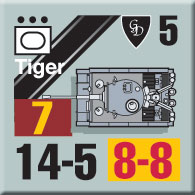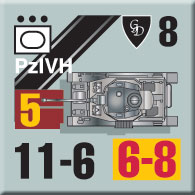Grossdeutschland 1944:
Scenario Preview, Part One
by Mike Bennighof, Ph.D.
April 2025
 Sometime over the past few years, I started designing games as an exercise in story-telling. It’s the way I taught and often write history, and I’m just much more comfortable looking at game design as an exercise in building a narrative flow. So when designing for a scenario-based game system like Panzer Grenadier, I look for a series of actions taking place over several days that I can weave together to tell a story. Sometime over the past few years, I started designing games as an exercise in story-telling. It’s the way I taught and often write history, and I’m just much more comfortable looking at game design as an exercise in building a narrative flow. So when designing for a scenario-based game system like Panzer Grenadier, I look for a series of actions taking place over several days that I can weave together to tell a story.
Those aren’t easy to find, not with the depth of detail needed to create a whole string of scenarios. But once you do have that, it all usually falls together pretty logically. You know what the stakes are in each of the scenarios, each of which then serves as a scene or act in the drama you’re crafting.
That’s how the core chapters of Panzer Grenadier: Grossdeutschland 1944’s scenario set came together. Let’s have a look at the first chapter.
Scenario One
Fortress Leuntea
20 August 1944
On the left flank of 4th Mountain Division (and its parent XXIX Corps), Soviet recon had accurately found the boundary with the neighboring XXX Corps (also the boundary between the German Sixth and Romanian Third Armies). To cover the gap between the two Axis armies and protect their open right flank, the Germans had built up a considerable entrenched position at Leuntea, a wine-growing village sited on the dry bed of the Dnestr River’s former course.
Conclusion
Leuntea had been turned into a fortress, surrounded by trenches, wire and minefields with a full battalion of artillery dedicated to its support. To add impetus to their attack, Sixth Guards Rifle Corps had stripped the second-echelon 195th Rifle Division of its medium and heavy mortar batteries and heavy anti-tank guns, attaching them to the two forward divisions to increase their firepower at the point of impact. The preliminary bombardment, supported by direct-fire weapons and mortars, obliterated many of the German fighting positions and the troops within them. The surviving German troops fought hard, but the Soviets applied maximum force and blocked the advance of a Romanian relief column. Neither reaction affected the Soviet advance, which rolled forward regardless.
Notes
Leuntea (I used the Romanian-language names for all places, rivers and such) is a mighty fortress, ringed with trenches and minefields and wire. The Soviets plaster all of it with artillery, and then attack in a massive wave of humanity backed by rockets and mortars, mortars and a few more mortars. It’s kind of like the old Green Berets movie but without Puff the Magic Dragon.
Scenario Two
Grenadiers
20 August 1944
 As Soviet assault divisions poured into the gaps they had torn in the Axis lines, the German Sixth Army and Romanian Third Army commands hurled whatever reinforcements they could locate into the fray. The German 15th Infantry Division, on the left flank of the disintegrating 306th Infantry Division, sent its 106th Grenadier Regiment to block the advance As Soviet assault divisions poured into the gaps they had torn in the Axis lines, the German Sixth Army and Romanian Third Army commands hurled whatever reinforcements they could locate into the fray. The German 15th Infantry Division, on the left flank of the disintegrating 306th Infantry Division, sent its 106th Grenadier Regiment to block the advance
Conclusion
The two-battalion German regiment slowed the advancing 187the Guards Rifle Regiment. The division command committed a second regiment, 189th Guards Rifle, and the Soviets rolled back the Germans amid heavy fighting. The Guards division reported capturing German strong points, but this doesn’t seem to have been the case - the German regiment arrived just as the Soviets began their advance.
Notes
It’s a meeting engagement, and the Germans are not pleased to meet the Guards. They actually have a fair chance of stopping the Soviet advance for a while, as the Soviets have temporarily out-run their artillery umbrella and only have their divisional guns. The Germans don’t have to accomplish much in order to win, which is a good thing, because they’re not going to accomplish much.
Scenario Three
Lucky Thirteen
20 August 1944
With news of 306th Infantry Division’s collapse, the German Sixth Army immediately ordered its mobile reserve to counter-attack the Soviet breakthrough. Thirteenth Panzer Division had been left in Romania when the other German armored formations left for the central front and had only 35 operable tanks. That made it the strongest of the three German mobile divisions in the theater.
Conclusion
The weak German armored counter-attack, aided by the remnants of 306th Infantry Division, managed to halt the Soviet advance and push them back slightly. The action had a far greater impact on the strategic level, openly demonstrating to the Romanian leadership that their German allies had reneged on their promise to deploy strong armored forces to defend the country against Soviet attack. Romania had only days left as an Axis ally.
Notes
We get a tank battle, with a small German armored force squaring off with a company of Stalin heavy tanks. The infantry are going to carry the brunt of the fighting, as is the usual course of battle, and the Soviets are going to have to maintain the momentum of a foot-bound advance against a mobile defender.
Scenario Four
Punishment at Popeasca
20 August 1944
 The German Army established its first punishment battalion in June 1941, a unit in which soldiers convicted of crimes could redeem themselves in battle and earn a return to their unit. Most of them died instead, as the battalions - seven more would eventually be formed - received the most dangerous missions. Holding the fortified village of Popeasca against two advancing Guards divisions seemed to meet that definition. The German Army established its first punishment battalion in June 1941, a unit in which soldiers convicted of crimes could redeem themselves in battle and earn a return to their unit. Most of them died instead, as the battalions - seven more would eventually be formed - received the most dangerous missions. Holding the fortified village of Popeasca against two advancing Guards divisions seemed to meet that definition.
Conclusion
Somehow, the condemned Germans held on in Popeasca. The Soviet division attempted to seize the town from the march and its troops arrived piecemeal, without stopping to organize themselves and make use of their much greater numbers or their support from the unstoppable Stalin heavy tanks. The 37th Army staff ordered Sixth Guards Rifle Corps to renew the attack with overwhelming force.
Notes
I’m pretty sure this is the first time a German punishment battalion has appeared in a Panzer Grenadier scenario. They do have some special powers (since no one cares if they live or die) but they are up against overwhelming force. It only gets worse from here.
Scenario Five
Final Sentence at Popeasca
20 August 1944
 Thwarted in their first attempt to take Popeasca, the Sixth Guards Rifle Corps command brought up another division and launched two regiments at the fortified town, one from either flank. The army command directed that tanks be deployed and the artillery of both divisions plus additional army-level artillery, Guards rocket batteries and mortars. Popeasca’s garrison was to be obliterated. Thwarted in their first attempt to take Popeasca, the Sixth Guards Rifle Corps command brought up another division and launched two regiments at the fortified town, one from either flank. The army command directed that tanks be deployed and the artillery of both divisions plus additional army-level artillery, Guards rocket batteries and mortars. Popeasca’s garrison was to be obliterated.
Conclusion
The Germans contested every building and every trench, but the Soviets rolled over them and wiped out the punishment battalion. A few scattered survivors made their way to German lines, and the battalion would be re-constituted to face the Soviets again. The massive application of force allowed Sixth Guards Rifle Corps to dispatch the German strong point quickly and be on their way.
Notes
When you use the story-arc format for scenarios, sometimes you have to include a few scenarios where one side is just utterly doomed. This is one of those scenarios.
Scenario Six
Night Action on Căuşeni Hill
20-21 August 1944
 When darkness fell, 37th Army’s energetic commander Lt. Gen Mikhail Sharokhin ordered that the offensive continue so as not to afford the Germans and Romanians any chance to reorganize their shattered divisions and bring up reinforcements. Not every division could comply, but the second-echelon 244th Rifle Division had served as a flank guard during the first day’s combat and seen little action. When darkness fell, 37th Army’s energetic commander Lt. Gen Mikhail Sharokhin ordered that the offensive continue so as not to afford the Germans and Romanians any chance to reorganize their shattered divisions and bring up reinforcements. Not every division could comply, but the second-echelon 244th Rifle Division had served as a flank guard during the first day’s combat and seen little action.
Conclusion
Sixth Guards Rifle Corps had hoped to begin the attack in the early evening, when the Germans were still discombobulated from the repeated defeats suffered during daylight. Instead it took several additional hours to bring the second echelon division to the front, allowing the Germans to dig in and re-organize. The Soviets, apparently not having recovered their mortar teams from the first echelon divisions, failed to eject the Germans from the hill and dug in at its foot to attempt another assault when the sun rose.
Notes
This one’s going to be fought out at close range in the dark, as the Soviets swarm up a large hill and the Germans have to push them off. The Germans have fortifications to help them, and they’re going to need it, because the Red Army wants their hill.
And that’s Chapter One. Next time, it’s Chapter Two.
You can order Grossdeutschland 1944 right here.
Red Storm Package
Broken Axis
Grossdeutschland 1944
Eastern Front Artillery
Retail Price: $139.97
Package Price: $110.00
Gold Club Price: $88.00
You can order the Red Storm Package right here.
Please allow an extra three weeks for delivery.
Sign up for our newsletter right here. Your info will never be sold or transferred; we'll just use it to update you on new games and new offers.
Mike Bennighof is president of Avalanche Press and holds a doctorate in history from Emory University. A Fulbright Scholar and NASA Journalist in Space finalist, he has published an unknowable number of books, games and articles on historical subjects.
He lives in Birmingham, Alabama with his wife and three children. He will never forget his dog, Leopold.
Want to keep Daily Content free of third-party ads? You can send us some love (and cash) through this link right here.
|
